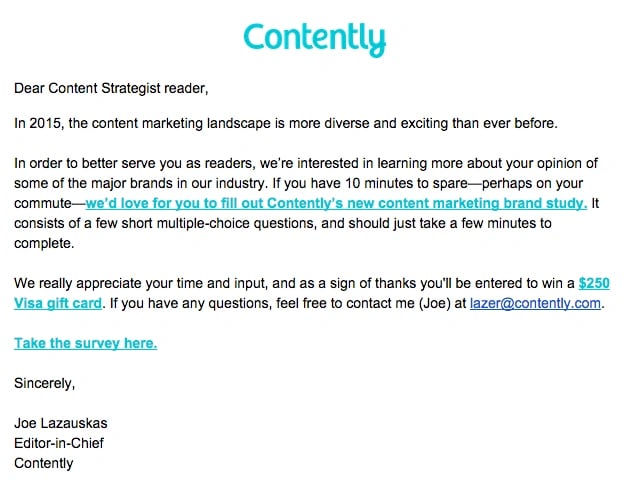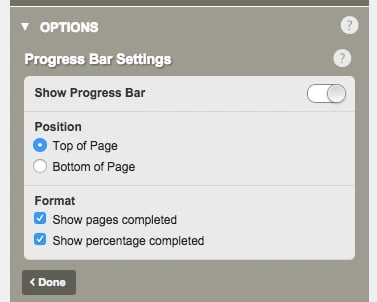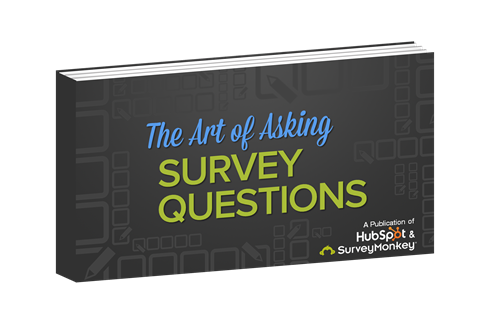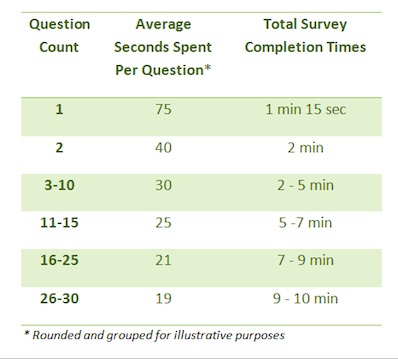For marketers, tracking meaningful data is key to understanding how to generate leads. Of this data, pointed feedback from prospects and customers is especially valuable.

The best way to collect it?
Surveys.
Done well, a single survey that follows best practices can yield eye-opening information -- the kind that forever changes the direction of an organization for the better. On the other hand, a poorly written survey will return useless data while creating a frustrating experience for the respondent.
So, why do these long, agonizing surveys persist?
Too often, marketers and researchers fall into the trap of focusing exclusively on their own need for answers, and not enough on the experience they create for the respondents. When that occurs, respondents sometimes take shortcuts through the survey (if they finish it at all), and neither party wins.
To right that wrong, we've laid out seven helpful tips to nudge your respondents through a whole survey in a way that creates a positive experience, without sacrificing the actionable information you’re seeking.
7 Tips for Creating Surveys People Want to Take
1) Explain why someone should participate.
When requesting input from someone, remember that you’re asking the person to take precious time and energy out of their day to help your organization. In cases when you’re not offering an incentive for participation, it's important to keep in mind that you’re essentially appealing to the good nature of your contacts. (The hope is that after all those metaphorical back scratches you’ve given, they'll be willing to scratch yours.)
So whether you’re soliciting feedback via a website page, an email, or some other means, you'll want to emphasize why it’s worthwhile for someone to weigh in. Specifically, what will your organization do with the information your respondents provide? Why should your respondents care about that? How will your respondents benefit from sharing their perspectives?
Here’s a little secret: In nearly every case, survey responses help your organization serve your customers and potential customers more effectively, right? Include that in your introduction. If you make it easy for people to see how completing your survey may improve their lives, they often feel more inclined to participate.
Here’s a great example of an enticing survey invitation from Contently:

As you can see, this approach is actionable, explanative, and incentive-driven. Well done, Contently.
2) Set expectations properly.
Have you ever taken a survey that felt like the Energizer bunny of surveys? You know, the kind that keeps going and going and going and ... you get the point.
By the end of it (assuming you even made it that far), you probably felt like you’d taken the Bar exam. (And any lawyer will tell you that's definitely not the experience you want to create for your respondents.)
Suffice it to say, much has been written about considerations for survey length. Whatever the final question count turns out to be, it’s in your best interest to help your respondents plan accordingly.
For starters, tell them approximately how long they should set aside to complete your survey. This will help to ensure that they don’t have to rush or abandon the survey because of a time constraint. In some instances it can also be beneficial to use a survey tool that indicates the respondent’s progress throughout the survey using a progress bar. According to Survey Monkey, “Progress bars can basically act like a coach, encouraging people to keep on trucking and reach that finish line.”
Survey Monkey gives you the option to specify what information the progress bar displays, where it's located, and even -- in a separate window -- what colors it is.
Whether or not that functionality is available in the survey tool you’re using, it doesn’t hurt to add written checkpoints into the survey like, “keep the helpful feedback coming -- you’re more than halfway done” and “only two more questions to go." These minor additions can mean the difference between your respondents quitting the survey or sticking it out for a couple more questions.
One more note on setting expectations: Sometimes, your survey asks more of the respondent than simply answering a few simple questions. For example, you may ask your respondent to upload a photo or complete a task offline and rate their experience afterwards. In cases like this, it’s worth giving your respondents a heads-up in your introduction that the survey they’re about to take requires extra effort. (It also wouldn't hurt to incentivize them for going above and beyond.)
3) Speak your persona's language.
When writing a survey, there’s often a temptation among marketers to make the phrasing of questions as dry and bland as possible. For many, this is probably rooted in the fear that inserting superfluous language may influence the results of the survey.
That’s a legitimate concern. After all, surveys aren’t supposed to entertain -- they’re supposed to elicit meaningful feedback. But surveys don’t have to be boring. In fact, surveys can and should engage the participants enough to inspire creative and constructive input that can be used to empower you to enact real change.
Though it sounds obvious, the best way to write a survey like this is to speak like a human being. As you would with your keyword research, use language that your respondents would use and will easily understand. That means minimizing your usage of acronyms, jargon, and phrasing that might confuse them.
Here are a handful of writing tips to consider when creating a survey that is engaging and free from bias:
- When you know you’re asking a particularly tough or demanding question, acknowledge it.
- Thank respondents in advance for providing thorough, candid answers.
- Offer words of encouragement if you’re requesting a detailed, open-ended response.
- Provide help text so that a respondent fully understands how to answer a question (so long as it doesn’t influence how he/she responds).
4) End on a high note.
Once your respondents have answered all your questions, you should give them the chance to have the last word. Rather than doing the survey equivalent of a “dine and dash," conclude instead with a question like this:
"Thanks again for taking the time to complete this survey. Your input means a lot to us, and it will help us improve our ability to serve customers like you more effectively in the future.
Before you go, do you have anything else you’d like to add?
- No, I’m all set
- Yes, I’d like to add: [open text field]"
Whether or not a respondent takes advantage of this opportunity to weigh in, it’s one that they'll see and appreciate because it’s an invitation to share (even more of) their own ideas and opinions.
However, if they do decide to chime in, their responses tend to be incredibly valuable. In fact, having written and reviewed hundreds of surveys, I've found that the real gems of insights almost always surface in this final question. Here are some examples of the feedback you could expect participants to touch on at this stage:
- Pointing out things you may have forgotten to ask.
- Circling back on topics that may have only occurred to them after the opportunity to share feedback on that given topic.
- Identifying questions or answer options that may have been unclear in the survey, and therefore are worthy of taking into account as you conduct your analysis.
- Sharing new product or service ideas.
- Providing helpful anecdotes that shed further light on who your respondents are, and context for why they responded as they did.
- Expressing their gratitude for the opportunity to contribute. (It's helpful to keep those folks in mind, should you need another round of input.)
- Offering other top-of-mind thoughts about your organization because they simply may not know where else to share it.
5) Take your own survey.
When you’ve put the finishing touches on the survey you're writing, take a step back, refill your coffee mug, and then take your own survey with a fresh set of eyes. Review your introduction and each question for clarity and empathy, and ask yourself:- Have I built a compelling case for why someone should take this survey?
- Is this the kind of survey my respondents will realistically start and finish?
- Are all of the questions I’m asking absolutely critical to my learning objectives?
- Does the language in this survey take into consideration the language that my respondents use and understand?
6) Close the loop.
What happens when a lead closes into a customer? Do you ignore them and move on to the next sale?
Of course not. Once closed, you continue to delight your customers so they become promoters of your organization.
And your survey respondants should be treated no differently.
After they've completed your analysis, the goal is to close the loop by explaining what you did with their input. By following up in this way, you're creating an opportunity to delight your respondents. Considering they've probably grown used to not hearing back from organizations in the past, this gesture will ensure that they feel as though their voices have genuinely been heard.
And after such a delightful experience, they’ll often be more likely to participate when you request their assistance in the future. They might even be willing to spread the news of their positive experience:
“HOLY SMOKES, I told XYZ Company what to do, and they actually listened!”
In the instance that your organization conducts its analysis and determines not to make any decisions or take any action, that’s not an excuse to leave your respondents hanging. You should still politely explain to them why your organization has decided not to make any moves. Often, the justification for no action is as intriguing as immediate action. Not to mention, that refreshing honesty will help to keep your organization in your respondents’ good graces.
7) Share the wealth.
Depending on the sensitivity and confidentiality of the information you're requesting from respondents, consider making the raw, anonymous results from the survey visible to respondents. This way, each person who completes the survey can see how their own responses compare to those of their peers. Again, it’s a surprising and delightful form of instant gratification. More than that, it’s a way to learn from -- and bond with -- others with whom they have something in common.
In Survey Monkey, the option is available under the Collect Responses tab when creating a survey. It looks like this:

One very important note: If any of your questions ask for personal identification information, do not display the results to respondents.
Before you start creating your next survey, bear these tips in mind, take a walk in your personas’ shoes, and make sure that you’re weighing your own learning objectives against the needs and agenda of those going out of their way to lend a hand.
What other methods do you use in order to elicit high-quality and complete survey responses?

![Blog - Buyer Persona Template [Updated]](https://no-cache.hubspot.com/cta/default/53/b9eb5e3d-dd13-4f36-9b7f-1ea13e714da2.png)


![How to Create Online Surveys People Will Actually Take [Infographic]](https://blog.hubspot.com/hubfs/Online_Survey_Tips.jpg)



